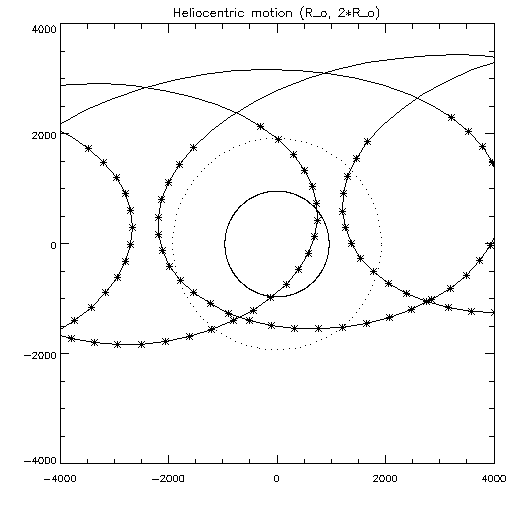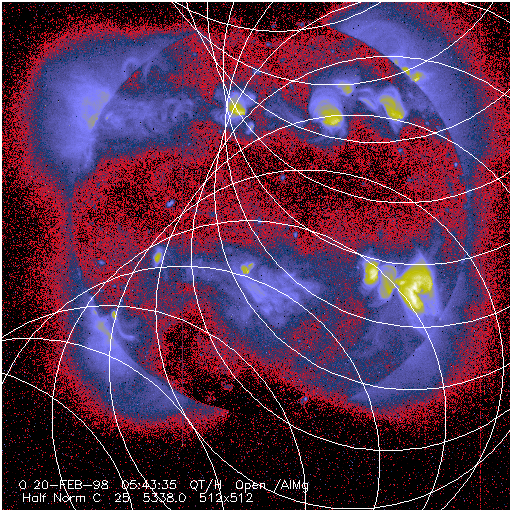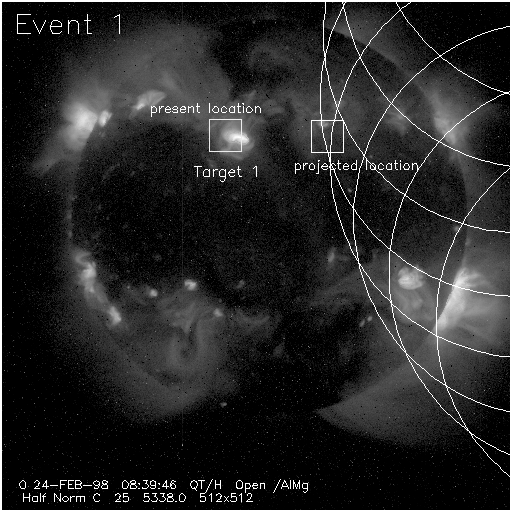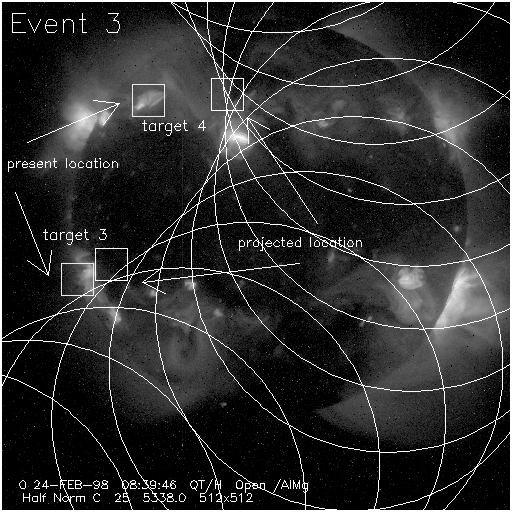
|

|
A well-situated solar eclipse is coming up on Feb. 26, and we are engaged in planning observations from Yohkoh. The rapid motion of Yohkoh makes it whiz in and out of eclipse several times, as shown in the plots below. Note that the Moon appears to go in counterclockwise loops, as seen in plots of this sort (N up, W to the right), and to drift from W to E. In the plots below, the asterisks indicate times of sunlight - in this rare case, all three eclipse episodes occur while Yohkoh flies above the sunlit face of the Earth.

|

|
While we do not yet know what the solar corona will look like on Feb. 26, we get a hint from observations one lunar period earlier, namely about Jan. 30. The following illustration shows a Yohkoh image from that date (18:48:59 UT, AlMg filter) with lines superposed showing the lunar limb every two minutes. The color table is reversed; N is up and W to the right. The heavy circle shows the predicted location for 18:50 UT, near the maximum obscuration, and the arrow shows the direction of motion of the lunar shadow. The lunar motion is quite rapid - an apparent speed of some 2300 km/s as it crosses the brighter active region to the SW.

In past eclipses we have tried to do grazing timing measurements during grazing occultation of a bright solar feature. This would be a way in principle to improve upon the angular resolution, a few arc sec, of the Yohkoh X-ray telescope. To do this right requires (a) a bright region, to provide enough photon counts to justify high-speed photometry (for Yohkoh this means one image per 2 sec at most); and (b) a suitably bright region that occurs at a position of tangent motion, where the limb of the moon appears to slide along parallel to itself. In this case the best position would be at the limb of the Moon next to the arrow, and unfortunately there wasn't a nice bright active region there on Jan. 30. But we can hope!
The Yohkoh SXT setup will probably emphasize an effort to get a clean and beautiful movie of the full Sun during the eclipse, assuming that a suitable active region does not occur. This is a tricky business because the Yohkoh pointing-control system must be especially prepared for the deep decrease in sunlight - and the apparent change in shape - during the eclipse. Otherwise Yohkoh pointing will swing precisely in response to where it thinks the Sun has gone, and this will make X-ray imaging more difficult.
If readers have suggestions, we welcome them! Please respond to sxt_co@isass0.solar.isas.ac.jp.

|

|

|
Please note that there is a sizable solar rotation involved here. In the first example (left above) the small boxes show the size of an SXT partial-frame image (64x64 pixels) at the current time (left) and after solar rotation to the time of the eclipse (right).

|

|

|
In order to get useful images of this faint target the exposure length was set to an intial value of 5.34 seconds. This value was determined by the on-board software to be insufficient, and so the exposure was automatically increased to the maximum value of 7.55 seconds. As a result, the image cadence will be degraded somewhat -- rather than acquiring an image every 8 seconds, we will now get an image every 10 seconds. This could have been avoided by setting the maximum exposure level to 5.34 seconds. However, a benefit is that the image quality and signal level in the resulting partial-Sun sequences will be somewhat better, owing to the 40% increase in exposure length.
Eclipse observation team: H. Hudson, R. Kano, D. McKenzie, T. Shimizu S. Yashiro